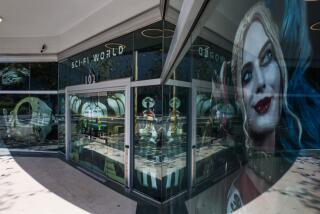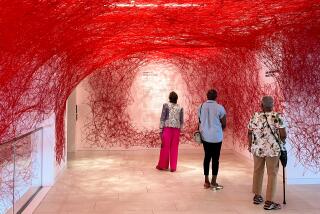Museum Dispute Focuses on Re-Created Time Cards : Audit: A Science Foundation auditor says the Natural History Museum may be âfakingâ records. The museum director says âNo.â
The Los Angeles County Museum of Natural History--already embroiled in an audit dispute with the National Science Foundation over more than $254,000 in grant money--has ordered employees to re-create, months after the fact, detailed records showing how much time they spent working on government-funded projects.
At the same time, the National Science Foundation has extended the ineligibility of the Natural History Museum to receive new federal grant money, warning the institution to develop a satisfactory accounting system by May 15.
The government action, disclosed in a Feb. 20 letter, leaves in force an action taken against the Natural History Museum last November. It came after science foundation officials demanded return of more than $254,000 for which the federal agency said the museum could not properly account.
To meet the foundationâs accounting guidelines, Natural History Museum employees last month were given nine working days to reconstitute time sheets for July, August and September, 1989. They were told to document what portions of their days were spent working on projects paid for by specific federal grants.
The instructions were contained in a widely circulated Jan. 29 museum staff memorandum; copies of it and related documents were obtained by The Times.
Employees were given copies of their original time cards and told to produce more detailed records on different forms. Employee time was allocated among as many as 11 federal grants, as well as seven museum divisions. In some instances, museum workers were required to account for work in half-hour units.
Under the old museum time-keeping system, an employee simply noted the total number of hours he worked on any given day. Under the new system, an employee must show how much time he works on museum projects (6.5 hours a day, for example) and how much time he works on grant-funded programs (1.5 hours).
Employees were paid last year at regularly scheduled intervals throughout the three-month period for which records have been reconstituted.
The Los Angeles County-owned museum has an annual operating budget of $16.2 million and employs about 300 people. The museum is operated by the county and the private Los Angeles County Museum of Natural History Foundation. Some museum employees technically work for the county and some for the museum foundation.
Disclosure of widespread re-creation of time cards at the museum appears to raise new questions about its efforts to rid itself of the National Science Foundationâs declaration of ineligibility. The federal grant ban--the first ever ordered against a museum by the National Science Foundation, the agency said--was imposed after federal auditors found widespread irregularities in museum grant account records.
Ironically, at the time of the audit that led to the museum being stripped of its grant eligibility, federal officials were critical of slipshod time accounting procedures that included alteration of time cards with white-out. Auditors complained that the altered records and other discrepancies made it impossible to determine how much time had been devoted to grant-related activities.
âI will look forward to locating these (newly generated) records at the museum,â said Cliff Bennett, the assistant inspector general in charge of the agencyâs nationwide museum audit program. Bennett said such reconstituted records would be useless in determining the amount of time actually spent on any federal grant. He said the retroactive generation of the time sheets could be characterized as âfakingâ the records.
However, Craig Black, the museumâs director, emphatically denied the reconstituted time cards had a deceptive intent. Asked if the new records were intended to produce time accounts the museum knew to be fabricated, Black exclaimed, âGood lord, no!â
The new time sheets, Black said, are intended âto reconstruct, as best as is possible for our own use this fiscal year, the way in which (scientists) are allocating their time.â Black emphasized that original time records--from which employees were instructed to develop the detailed retroactive time sheets--are being retained and would be available to federal auditors.
Introduction of the new time card system first occurred last October, when the museum altered its time-reporting procedures through the use of a new form that makes it possible to itemize all working hours, dividing time among grants and other museum activities. Starting Oct. 1, museum employees switched to reporting their time worked every two weeks on the new forms--a type of simultaneous record-keeping government auditors encouraged.
Instructions issued by Black with the new time sheets noted that âthese new procedures have been imposed as a result of changed regulations and requirements of the National Science Foundation and others interested in the museumâs financial operations. These programs are critical components of our financial support and essential to our professional development and growth.â
But within the museum, the order to produce the new, retroactive, time records apparently provoked concern among employees. Museum sources said many scientists and other workers questioned whether they could be expected to accurately recall precise details of time worked months ago.
Last yearâs federal audit and resulting disqualification from new grants was widely seen as sensitive within the nationâs museum community because Black is a member of the National Science Board, the foundationâs governing body. He is the only museum director in the country to serve on the panel.
The Natural History Museum audit was among the first to be completed in an expanded and intensified National Science Foundation program that has targeted 19 museums at random across the country for financial scrutiny. The science foundation also questioned more than $100,000 in grant expenditures at the California Museum of Science and Industry.
In January, museum officials traveled to Washington to meet with science foundation auditors and grant officers. At the time, museum officials told staff members they could expect the federal grant ineligibility to be removed within a few weeks--perhaps a few days.
Last week, however, Jeff Fenstermacher, assistant director of the science foundationâs directorate for administration, notified museum officials that the grant ineligibility was being left in effect pending a review set for May 15. Fenstermacher said he had technically rescinded a grant officerâs decision that the museum had to return the entire $254,758 to the government. Fenstermacher said any amount to be returned will be subject to negotiation between the science foundation and the museum.
But while Black said the federal agency is accepting natural history museum grant applications, Fenstermacherâs decision indicated the government had decided to withhold any new grant awards indefinitely. The federal agency has relaxed the restriction on one occasion, releasing $500,000 in funds for a new bird hall because private-sector matching funds would have disappeared unless the federal share was paid out.
The original science foundation audit included 21 grants issued between 1982 and 1987. Fenstermacher said he had ordered foundation officials to expand the period under scrutiny and to review grants made through last year, as well. âAs Iâm sure you will agree, the dispute between your organization and (the National Science Foundation) has gone on long enough,â said Fenstermacherâs letter, addressed to Mark Rodriguez, the museumâs deputy director for administration. âIt is time to come to closure.
âIn reviewing your current accounting system and internal controls, it appears that although improved, they are still not acceptable to (the National Science Foundation.) I encourage you and your staff to work closely and expeditiously . . . so we can get this matter behind us and establish a stable relationship.â
In a telephone interview, Fenstermacher said the government took the unusually drastic action of disqualifying the entire museum for grant money after attempting for months, without success, to force the museum to develop improved internal financial controls.
âWeâd had a lot of trouble getting them to settle down and get serious,â Fenstermacher said. âWhen we cut off the water (so to speak), it got their attention. I want them and us to get together. Iâm not willing to process any more (grant) proposals or make any more awards until the whole thing is wrapped.â
Black said he was âvery pleasedâ with Fenstermacherâs letter to the museum, saying that the science agency had, for the first time, confirmed the amount of money in dispute is open to negotiation. âThis (letter) acknowledges that there is some justice and justification on our part,â he said.
Most at issue in the dispute is what the science foundation contends is an unacceptably high rate of indirect, administrative costs that the museum includes in its grant budgets. Black announced at a Feb. 1 museum staff meeting that the accounting firm of Arthur Andersen & Co., the museumâs regular outside auditor, had been additionally retained to help negotiate higher administrative cost rates with the science foundation.
The government audit, however, also concluded that museum researchers double-billed for more than $13,000 in equipment costs that were listed simultaneously on two grants and identified several other questionable expenses.
More to Read
The biggest entertainment stories
Get our big stories about Hollywood, film, television, music, arts, culture and more right in your inbox as soon as they publish.
You may occasionally receive promotional content from the Los Angeles Times.










